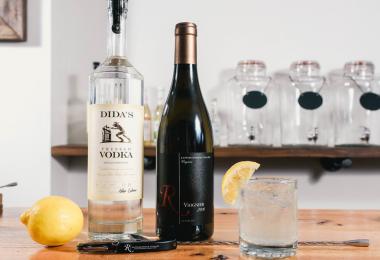Leisure visitors to South Africa generally have a limited checklist on their itinerary. Those who travel to the inland areas usually visit one of the game reserves in the vicinity of the world famous Kruger National Park. If they are visiting Cape Town they spend a few days in and around the waterfront, include an ascent of Table Mountain, and then make their way to the nearby winegrowing areas. If wine is part of the reason they have come to South Africa – and winery visits are now regarded as one of the three biggest drivers of the country’s tourism industry – there is a better than one in 10 chance that the Fairview Estate near Paarl will be a prospective destination.
The way it was
Forty or 50 years ago the travel itinerary would have been different: animals in the wild would still have been a primary attraction, but many would have included Johannesburg – the City of Gold – and a visit to Gold Reef City. The wine estates of the Cape would hardly have featured. This change, in which wine tourism has become a focal point for international visitors, has been gradual but inexorable. While it is a worldwide trend, its extraordinary growth in South Africa has been the result of a unique dynamic.
Part of the reason wine tourism was largely absent in the 1960s and 1970s is that very few vineyards were open to the public. Unlike in Bordeaux, for example, where there is a “visit by appointment” culture, the absence of cellar door sales helps explain South Africa’s apparent lack of hospitality. At the time, the major wholesalers enjoyed total control of the route to market. They bought the fruit, or juice, or bulk wine, from the estates and managed the entire commercial process from that point onwards. Growers who refused to accept this were boycotted by the bulk buyers.
It took well over a decade for this system to collapse. The first growers who broke ranks and risked everything to undermine the wholesalers’ monopoly were compelled to become very commercial, very quickly. They formed the Stellenbosch Wine Route, the first of many regional wine routes in South Africa, and created a hospitable environment to attract passing trade. Long before the current obsession with databases and newsletters, they gathered visitor details and developed a “mail and rail” retail business. A few of them added restaurant areas to the winery tasting room. All of them went to visit the major retailers in an endeavour to create a relationship that bypassed the wholesalers.
At much the same time, legislation identifying areas of origin and demarcating wine estates was promulgated. Even proprietors who had not yet decided to risk a confrontation with their trade customers started to raise their profile. Gradually these producers introduced limited bottlings of their own wines. While the threat of a boycott from the wholesalers remained, it became increasingly difficult to implement: it was a very clear breach of competition law, and as more and more producers asserted their independence the wholesalers could ill afford to apply the boycott. Wine tourism, directed mainly at domestic consumers, suddenly became a way of life.
During the course of the 1980s, at least 50 wineries in Cape Town’s vicinity opened their doors to the public and the concept began to acquire critical mass. For visitors in a hurry, Constantia was 15 minutes’ drive from the centre of the city. For those with slightly more time, Stellenbosch – home to the majority of the independent producers – was the obvious destination. Paarl, less than an hour’s drive from Cape Town, attracted more adventurous visitors, or those who sought more variety in their selection.
A powerhouse emerges
In 1974, in the midst of this dynamic growth, the Fairview Wine Estate in Paarl began bottling wine for the first time. Initially only a small portion of the farm’s production was offered for sale under its own label, and a significant percentage was sold to a couple of major retailers, mainly in and around Johannesburg. An old horse stable was converted into a tasting room and Cyril Back and his son Charles opened Fairview’s doors to the public. Business was slow: the premium wine market was more than 1,500km from the farms. Consumers from Johannesburg visited mainly over the December holiday season, making it a once-a-year opportunity to acquire new customers.
The next innovation – the one which gave the property its defining icon – came in 1981: a goat tower was built for the small herd of goats grazing on the farm. Those who came to the tasting room were able to watch the goats ascend and descend the tower – and they talked about this to their friends. It was a small point of difference, inexpensive to erect, but it gave Fairview crucial added visibility. In 1982 goats’ cheese production began, and with this development, the Fairview name achieved greater reach. It was an era when visitors were looking for food and wine experiences. Cheese production grew, extending beyond goats’ milk products to a range of the most popular styles of cheeses in the market. Sold under the Fairview brand, bearing the estate’s goat tower icon, and present in many of the more upmarket grocery chains, the cheese contributed to a massively enhanced visibility for the wines.
By the mid-1990s there were more than 100 wineries trading directly with the public, all vying for visitors. Cellar door sales needed more than just a large parking lot, a tasting counter manned by students, and a despatch from which visitors could collect their purchases. The areas had to look good. There needed to be tables and chairs where guests could sit and enjoy the experience of being on a wine farm. Ideally food needed to be available, either as a light snack to accompany the tasting, or at a restaurant adjacent to the tasting room.
Once Charles Back had taken over from his father Cyril in the mid-1990s, his marketing vision crystallised, his approach became more methodical and the spirit of innovation became even more evident. Accordingly there was nothing amateur about the way Fairview anticipated this trend, and effected a redesign to accommodate it. A garden was added in front of the tasting room which was itself revamped and, over the years, upgraded a number of times. Finally, after the turn of the millennium, when the old Fairview cellar was replaced with a new, more technically functional facility, the old winery was transformed into the Goatshed restaurant. Today there is also a shop stocking Fairview products. These have grown to include bread baked from farm-grown wheat, olive oil, fruit preserves and free-range meat from the estate’s pasture-reared cattle, sheep and pigs.
About 20 years ago, Back became a minority shareholder in one of the first Swartland region wineries. Within a few years he bought out the other shareholders in the project – called Spice Route – and developed it as a separate brand with its own winery, fruit sources and personality. It was however off the beaten track, even more so than Fairview had been 30 years before. It was clear that it needed a brand home and hospitality environment closer to where there was proven tourist traffic. Back’s opportunity came when De Leuwen Jagt, adjacent to Fairview, came up for sale. He bought the property and transformed it into Spice Route Destination in 2012.
Back’s key direct interest in the retail set-up is the Spice Route wine tasting centre and one of the restaurants on the premises. He also has equity in a craft brewing operation. Here tourists can actually see a working brewery and sample its production in very much the same way as winery visitors get to taste wines and then decide on their purchases. The very concept of housing a brewery on a wine estate shocked many in the wine establishment: traditionally the two beverages have been seen as direct competitors. Back thought otherwise. He recognised that not every member of every family visiting a wine farm shares the same passion for the fruit of the vine. By adding beer he created an opportunity to extend sales beyond his traditional market and to make Spice Route Destination more appealing to a wider group. He also argues that there’s no conflict if both the wine and the beer reflect the same production philosophy. “Craft is not confined to product, but rather an approach driven by passion, dedication and sustained commitment. Products made against this backdrop all have synergies,” is how he puts it. With the same vision and, accepting that breadth of offering can sometimes be more appealing within the same catchment, he encouraged owner-managed artisanal businesses to become tenants at Spice Route. They contribute a percentage of their turnover to the enterprise.
A model business
Charles Back has not only dramatically changed the nature of his business in 40 years, but he has created a template which is increasingly being emulated elsewhere. The Glenelly Estate in Stellenbosch is less than 15 years old but already has a bistro restaurant and a glass museum with exhibits dating back to ancient times. Spier has several restaurants, a hotel and a cheetah outreach program where visitors can see these magnificent cats and learn firsthand about conservation efforts.
Charles Back recognised that “for a family-based winery, tourism is potentially its greatest differentiator in a very cluttered market. It gives the smaller operators an opportunity that large-sized wineries find difficult to compete with.” When the tasting room at Fairview first opened, the facility attracted no more than a couple of visitors a week, perhaps 10 in a month. Now, depending on the season, the monthly numbers range between 20,000 and 25,000. A similar number of shoppers descend on Spice Route Destination and combined on-premise turnover exceeds $8m. There are no major hotels nearby, and no public transport. Cape Town is 50km away, yet for the more than 500,000 visitors who make the trip annually, Charles Back’s wine tourism enterprises have become a destination.








